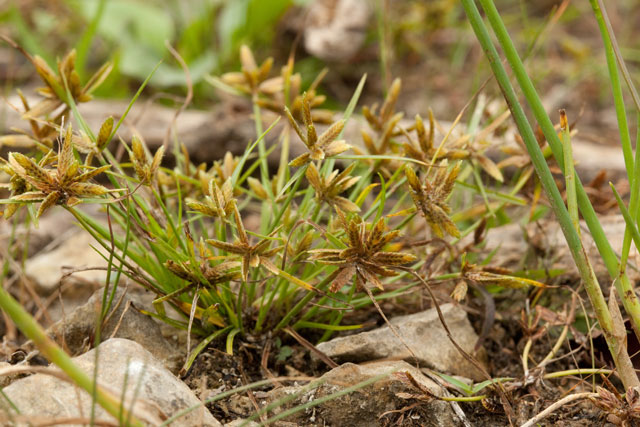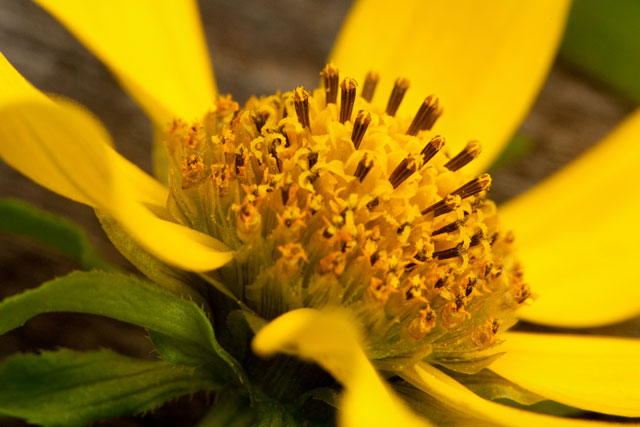

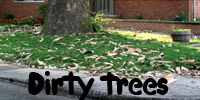
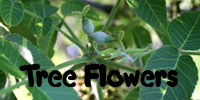
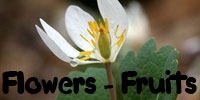
(Additional content at flickr Photostream and YouTube Channel)
If you have botany questions or comments please email BobK . Thanks!
Tortula pagorum
Columbus, Ohio. September 30, 2009
There
is a retirement community in northern Columbus, Franklin County, Ohio
that is an excellent place to be retired. My wife and I have beloved
family members who live there, and one late-September afternoon we
communed with them.
We had great fun chatting about this and that, and then we left to go
home. Outside, along the walking path to the parking lot, there is an
ornamental maple, the trunk of which is covered with mosses.

Moss-covered maple tree. Columbus. Ohio. September 30, 2009.
It's always fun to see "corticolous" (bark-inhabiting) bryophytes, especially in the city where moss diversity is somewhat limited. That being said, there are a few mosses that do especially well in cities, among them epiphytes such as several species of Orthotrichum (family Orthtrichaceae) and an interesting asexually-reproducing member of the Pottiaceae, Tortula papillosa.
For example, in the "flashback" picture below, we them cowering beneath the (daddy?) long leg of a harvestman, a couple years ago on a brick wall (where they also may occur, expecially if there are source-population trees nearby). Note the broad, hair-pointed leaves of the common Tortula species --T. papillosa, which can be distinguished at a glance by abundant tiny globe-shaped gemmae (asexual propagules) covering the midevein along the upper surface of the leaves.
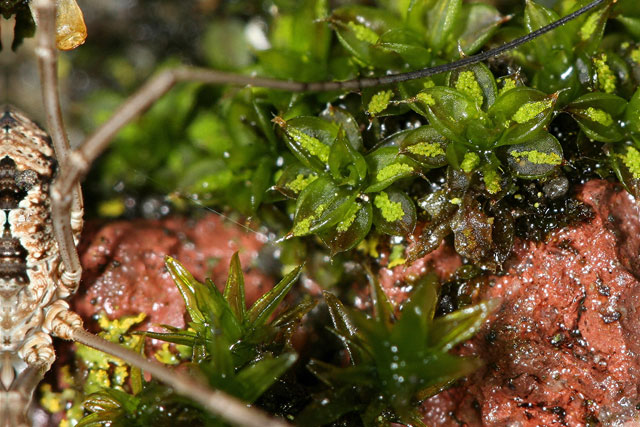
Tortula papillosa (and a smidge of Orthotrichum) on a brick wall. May 5, 2007. Columbus, Ohio.
At first glance, the
community on this maple tree seemed to be the same as usual, i.e., some
as-yet-unknown species of Orthotrichum
mixed with T. papillosa.
Since Orthotrichum
species are an enjoyable challenge to identify, requiring detailed
microscopic examination of the breathing pores (stomates) on the
capsule (sporangium), I chipped off a few pieces of bark for later
scrutiny. When we got home and looked through the dissecting scope
however, interest in the Orthotrichum
fell to the wayside (and never returned, as, alas, the capsules
were too immature to identify). There within a lush patch of the
common Tortula papillosa
were a few stems of another Tortula
...not one with tiny globose gemmae, but one having somewhat
larger leaf-like gemmae! Tortula
pagorum!
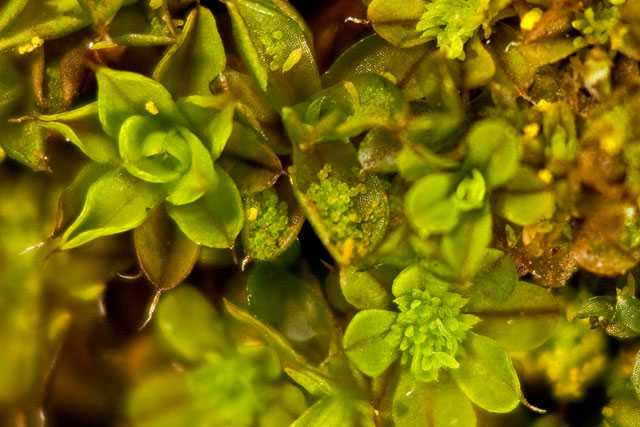
Tortula papillosa (center) and T. pagorum (upper and lower right).
Tortula pagorum is an uncommon moss in Ohio. How do we know? By consulting the 1996 Ohio Biological Survey publication "A Catalogue and Atlas of the Mosses of Ohio," by Jerry Snider and Barbara K. Andreas (revised 2007). It includes a brief history of Ohio bryological studies, instructions for studying and preserving mosses, a list of the 400+ Ohio species, a separate list of synonyms, and county dot maps distinguishing between counties for which only literature records are known (denoted by squares on the maps) and those for which there are specimen records (circles).
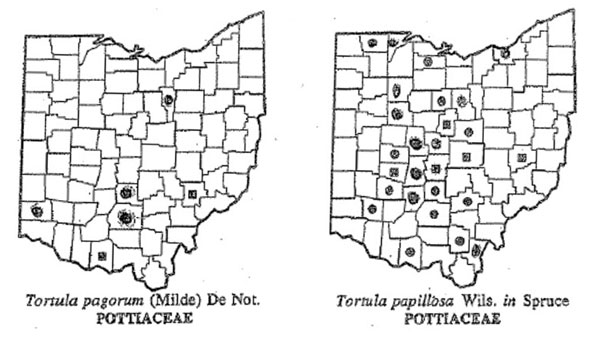
Distribution of two Tortula species in Ohio.
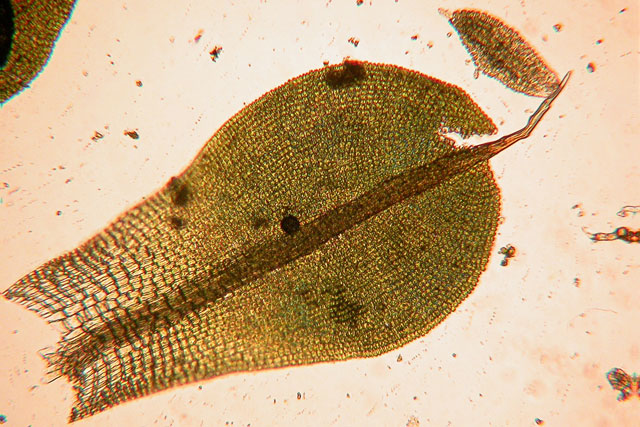
Tortula pagorum leaf.
...and a closeup of a propagulum:
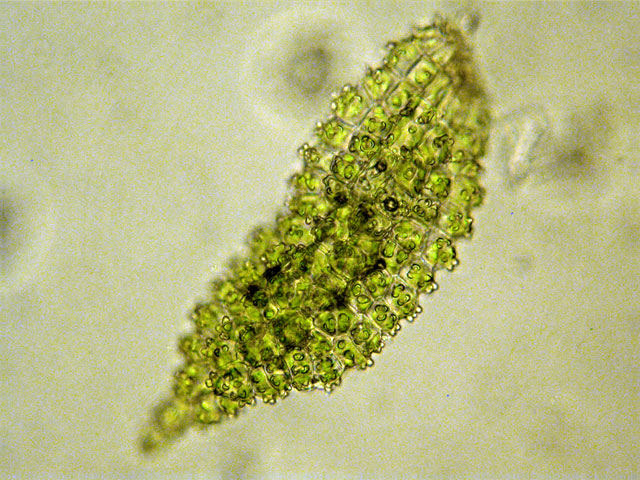
Tortula pagorum propagulum.
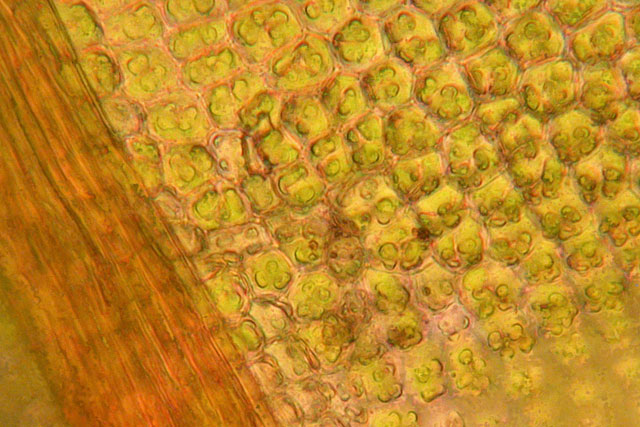
Tortula pagorum leaf papillae.

Tortula papillosa (center) and T. pagorum (upper and lower right).
Tortula pagorum is an uncommon moss in Ohio. How do we know? By consulting the 1996 Ohio Biological Survey publication "A Catalogue and Atlas of the Mosses of Ohio," by Jerry Snider and Barbara K. Andreas (revised 2007). It includes a brief history of Ohio bryological studies, instructions for studying and preserving mosses, a list of the 400+ Ohio species, a separate list of synonyms, and county dot maps distinguishing between counties for which only literature records are known (denoted by squares on the maps) and those for which there are specimen records (circles).

Distribution of two Tortula species in Ohio.
Here's a microscope view
of a T. pagorum leaf and a
detached propagulum:

Tortula pagorum leaf.
...and a closeup of a propagulum:

Tortula pagorum propagulum.
As seems to be the case
when "good" species are recognized, there isn't just one feature
separating T. papillosa and T. pagorum, there are others.
The leaf cells of T. pagorum
are densely papillose (shown below) while those of T. papillosa (not shown, sorry)
have papillae simple or lacking.

Tortula pagorum leaf papillae.
According to the species
description in Crum and Anderson's (1981) Mosses of Eastern North America, Tortula pagorum
occurs "on bark, often at the base of roadside trees, especially on
elms, sometimes also on rocks, bricks, or stone walls, nearly always
associated with human habitation in eastern North America, more common
southward." Both of these Tortula
species occur in other continents as well. Interestingly, only female T. pagorum
plants have been found in North America while in Europe there are only
male plants. The only fruiting individuals were described from
Australia!
This teeny little thing with nearly radial flowers is a mint?
False pennyroyal at Marion Quarry Park
September 25, 2009
The
mint family, Lamiaceae, is a fairly well marked one. Look
for simple leaves arranged opposite one another on square stems,
and flowers with 5 fused sepals and petals and a bilateral symmetry
that is "bilabiate," i.e., two-lipped...the family has also
been called the "Labiatae."
Here are some representative mint family flowers. It's a little biased to be sure, in the direction of showy and bilateral. As counter-examples, common mint (Mentha) and water-horehound (Lycopus) have small regular (actinomorphic, radially symmetric) flowers.
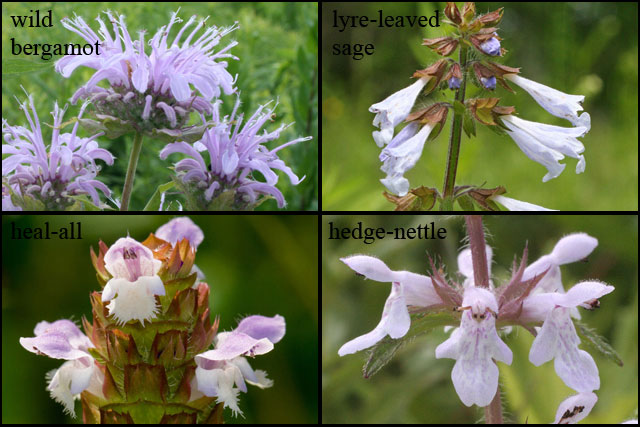
Typical mints with showy two-lipped flowers.
Here are some representative mint family flowers. It's a little biased to be sure, in the direction of showy and bilateral. As counter-examples, common mint (Mentha) and water-horehound (Lycopus) have small regular (actinomorphic, radially symmetric) flowers.

Typical mints with showy two-lipped flowers.
Here
on a dry limestone ridgetop is a delicate little wildflower with a
deeply lobed corolla that is nearly radially symmetric. It doesn't
exactly scream "Lamiaceae" except for one thing: the fruits. The ovary
of mint family flowers is deeply 4-lobed, and in fruit presents a
compact squarish quartet of 4 small nutlets. Peek into the calyx
(Pennyroyal, say "ahhh!") and you see this feature, lowermost in the
photo. The plant is Isanthus
brachyactis, false pennyroyal. The name "Isanthus" is from Zorba (isn't he
"the Greek"?) isos, equal,
and anthos, flower, referring
to the regular calyx and nearly regular corolla.
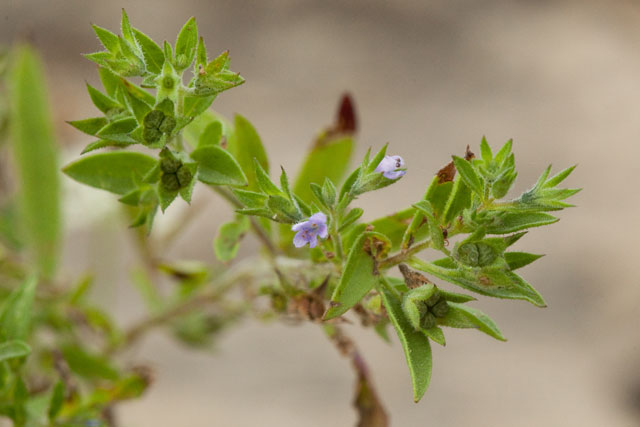
False pennyroyal at Marion Quarry Park. September 25, 2009.

False pennyroyal at Marion Quarry Park. September 25, 2009.
Yerba-de-tajo and other weedy wetland plants
Marion Quarry Park, September 25, 2009
On the northern outskirts of Marion, Ohio, an abandoned limestone quarry is now a park where people go to fish. I went there late Friday afternoon to try and chalk up a few new moss species for the county moss list. Well that didn't happen, but along the shore there are some intriguing wetlandish (I disabled "spell-check"; those little wiggly lines get on my nerves.) plants. Here's the shore.

Quarry Park lake shore. September 25, 2009. Marion, Ohio
This shore is the site of a dense population of a charming little fibrous-rooted annual sedge, some species of Cyperus (galingale). Among our 12 sedge genera, all but two have their flowers arranged in a spiral fashion. Cyperus (and Dulichium) stands out by having flowers in two ranks or rows on opposite sides of the flowering axis (a tiny fower cluster called a "spikelet").
Here's a picture of the sedge. It keyed out OK, but I forget its name. It's either C. flavescens, C. rivularis, C. filicinus, or C. diandrus.
MOUSEOVER
THE IMAGE FOR A
CLOSEUP OF THE SPIKELETS
Pretty
abundant annual sedge at Marion's Quarry Park. September 25,
2009.
Here's a
little annual member
of the Asteraceae that is regarded as
weedy even though it is native. It's Eclipta
prostrata (also
known as E.
alba), a
species of
southern affinity. Quite an odd common name: "yerba-de-tajo."
Translation?
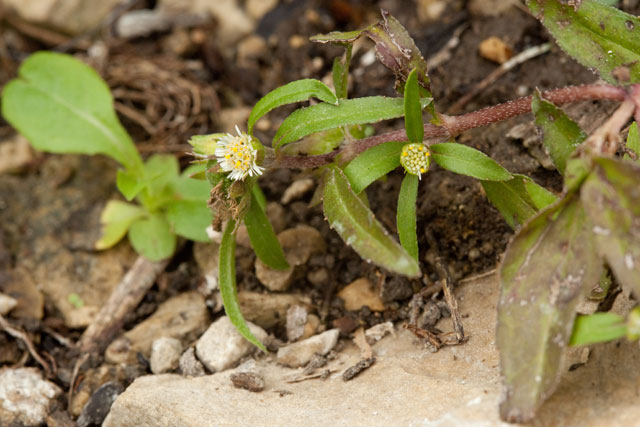
Yerba-de-tajo at Marion Quarry Park. September 25, 2009.
Also in the Asteraceae, two species of "beggar's-tick," members of the genus Bidens. These are opposite-leaved plants with, in some instances, showy yellow large-rayed flower radiate flower heads. Again, they are native species, but generally associated with disturbed ground, regarded as more or less weedy.
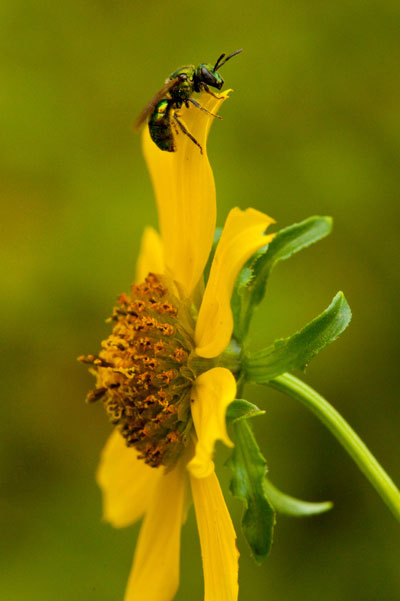
Nodding beggar's-tick. Sept 25, 2009. Marion, OH.
Nodding beggar-tick, Bidens
cernua,
has simple, toothed, lanceolate leaves and large heads with showy ray
flowers that are moderately nodding while in flower, and nod even more
in fruit.
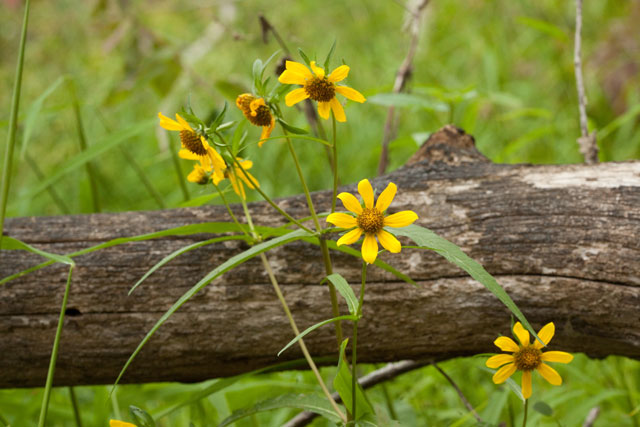
Nodding beggar-tick at Marion Quarry Park. September 25, 2009.
The flower
heads of Bidens
display fairly well the unique flower structure of the Asteraceae, in
which many very small floaers are packed together into a head-like
inflorescense --a "capitulum" --that simulates an individual flower.
The petal-like flowers on the periphery of the head are strap-shaped
sterile "ray flowers," while the radially symmetric disk flowers are
the ones that both distribute pollen and develop fruits.
Aster family flowers are 5-parted, with 5 petals fused at the base but flaring tinto separate lobes, and 5 stamens that are fused into a tube. The stamens split and release pollen along the inside of that tube, and the pollen is presented on the backs of the style-brances and stigma lobes. The details are pointed out in the zoom-crop of the Bidens head (mouseover).
Aster family flowers are 5-parted, with 5 petals fused at the base but flaring tinto separate lobes, and 5 stamens that are fused into a tube. The stamens split and release pollen along the inside of that tube, and the pollen is presented on the backs of the style-brances and stigma lobes. The details are pointed out in the zoom-crop of the Bidens head (mouseover).
MOUSEOVER
IMAGE TO SEE ZOOM-CROP OF BIDENS
DISK FLOWERS
The basis
for the common
name is an eleagant (elegant?,
harumph!, tell that to yourself while you're picking them out,
one-by-annoying little one, from your pants and socks at laundry-time)
dispersal adaptation. Atop each achene (a one-seeded fruit that is
little more than a seed) is a pair or backwards-barbed spiny appendages
that hook onto passing animals.
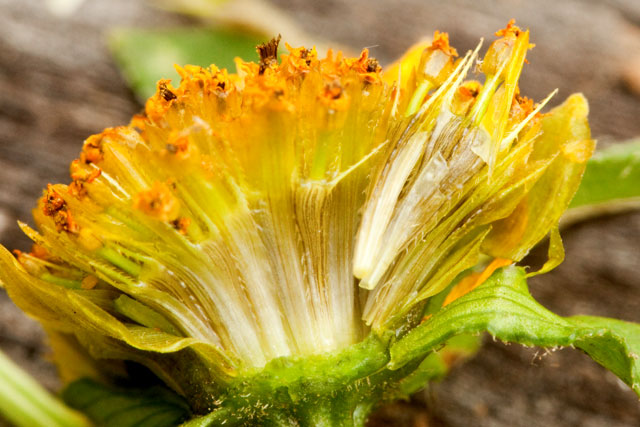
Annoying hookey things (retrosely barbed pappus) of "beggar's-tick."
Another
species, less showy,
is a rayless one, devil's beggar's-tick, Bidens frondosa. It
probably
self-pollinates. Not
evident in the photo, this one has pinnately compound leaves.
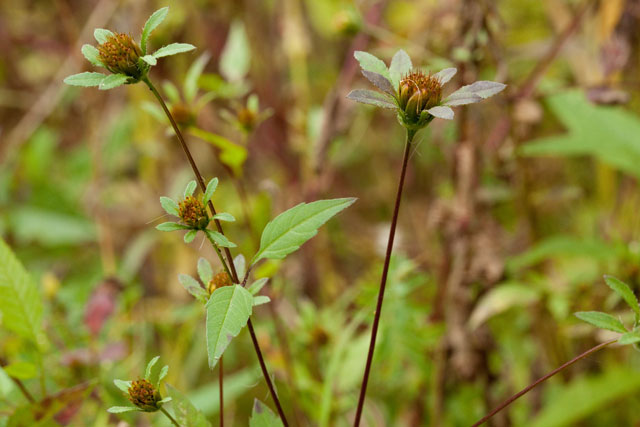
Bidens frondosa, a rayless "composite." Marion Quarry Park. September 25, 2009.
Conspicuous
in fruit is a member of the Rosaceae resembling a strawberry, but not
quite. Strawerry is the genus Fragaria, also in the Rosaceae.
This insipid lookalike is "Indian-strawberry," Duchesnia indica.
This native oif Asia, established in moist waste places, is the only
other instance, besides Fragaria,
of the weird fruit type wherein the fleshy part is the expanded
dome-like receptacle of an individual flower, upon which are situated
many single-seeded fruits (achenes), each derived from separate carpels
of an apocarpous gynoecium (i.e., one that has several-many pistils on
one flower).
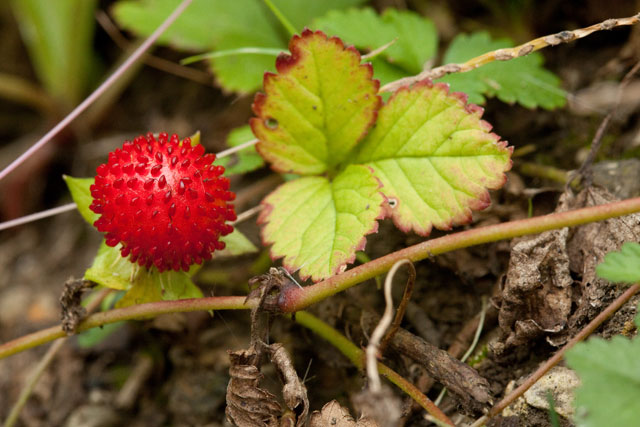
Indian-strawberry in fruit at the Marion Quarry Park. September 25, 2009.
While scrambling about the
rocks, it's a good idea to avoid posion-ivy,
Toxicodendron radicans (Anacardiaceae, the cashew family).
Remember the maxims:
"Leaflets
three, let
it be." "Drupes white, run in fright!" "Adventitious roots, use your
boots!"
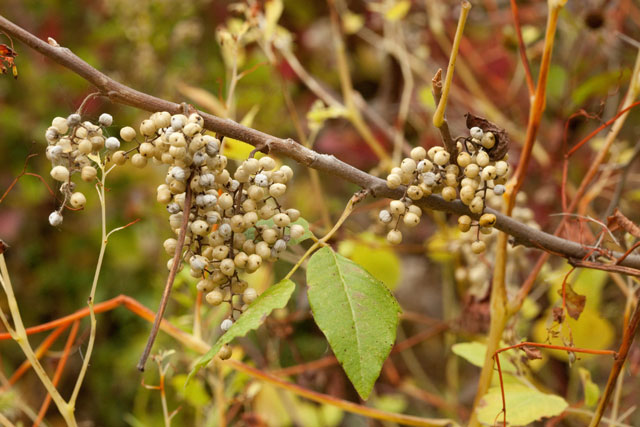
Poison-ivy in fruit. Marion Quarry Park. September 25, 2009.

Poison-ivy in fruit. Marion Quarry Park. September 25, 2009.
Searching for bryophytes in Meigs County, Ohio.
OMLA Fall Foray: September 19, 2009
The Ohio Moss and Lichen Association (OMLA) is an informal group of people interested in the study of bryophytes (not just mosses by the way...liverworts and hornworts too...shouldn't it have been named "OBLA"?) and lichens. The group promotes amateur and academic study of these organisms through field trips (forays) and occasional indoor lab/workshops where we tackle challenging identifications and also provide friendly instruction to beginners in lichen/bryophyte ID. Log on to the OMLA website, click on the "Upcoming Forays" link, and mark your calendar.
Because statewide distribution records are kept on a county-by-county basis, OMLA forays target under-studied counties. This year's fall foray went to Meigs County, in the southeastern part of the State. Meigs is a border county along the Ohio River in southeastern Ohio that is rural and forested, but unlike several adjacent counties that have 100+ mosses talled, until today only 50 mosses species had been recorded from the county. The lichen total, 98 species, is much more representative, but we're always on the lookout for more. The foray was attended by 13 people. The "official" write up of the Meigs County foray can be found here and in the December 2009 issue of OMLA's newsletter, "OBELISK."
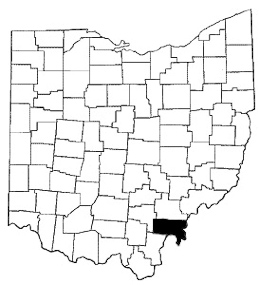
Meigs County
Our
first stop was a rest
area along Rte. 33, a grassy area with widely spaced trees. One of the
best parts of OMLA forays is seeing how dignified people look with
their noses pressed against tree trunks, talking to
trees, in search of sundry corticolous beauties.
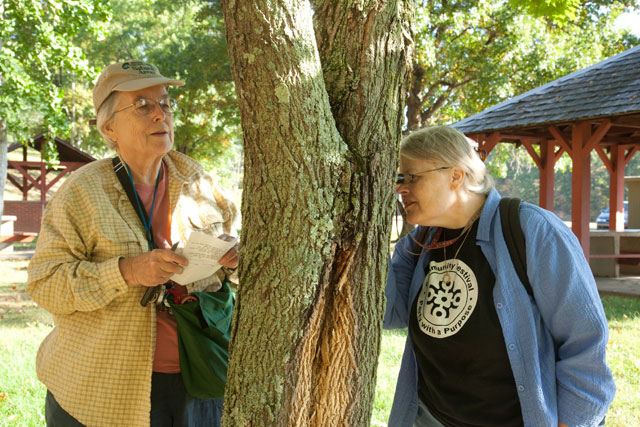
OMLA members seek epiphytic bryos at roadside rest. Meigs County, OH. Sept. 19, 2009.

OMLA members seek epiphytic bryos at roadside rest. Meigs County, OH. Sept. 19, 2009.
Here
is a foliose lichen,
possibly Flavoparmelia
caperata,
growing on one of these trees along with a moss, possibly Pylaisiadelpha
tenuirostris (family
Hypnaceae).
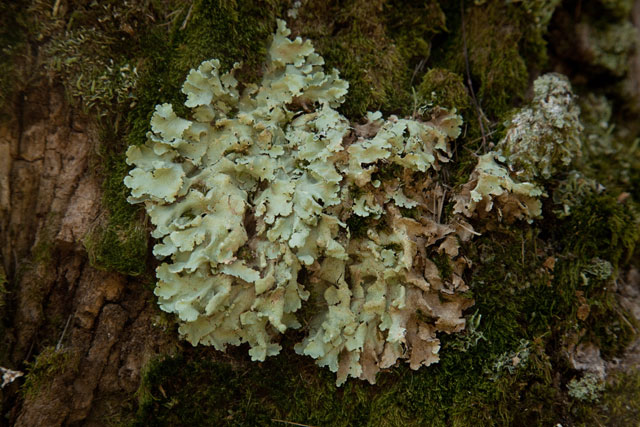
Like the members of OMLA who study them, moss and lichen mix and mingle.
Even though it's just a lawn area, we managed to be some interesting vascular plants there. One of these is a fall-sporing fern, the lace-frond grape-fern, Botrychium dissectum (family Ophioglossaceae).
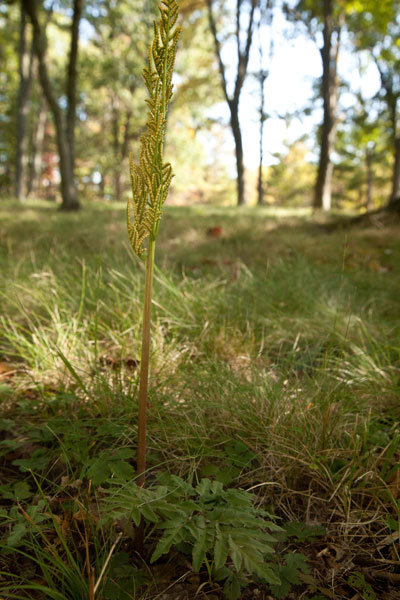
Lace-frond grape-fern in Meigs County rest area lawn.
This fern displays well the basis for both its genus and common name --from "the" Greek (is "the Greek" different from, say, Greek?), botrys, a bunch of grapes, alluding to the panicles of sporangia. Grape ferns have huge sporangia. Here's a closeup of the sporangia of this grape fern.
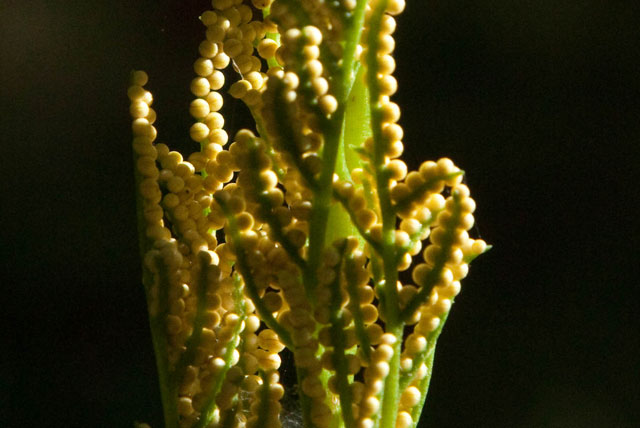
Grape fern sporangia at the Meigs County Rte 33 rest stop. Sept. 19, 2009.
Another vascular plant that caught our eye was a Spiranthes orchid, in fruit. Chances are good it's narrow-leaved ladies'-tresses, S. vernalis.
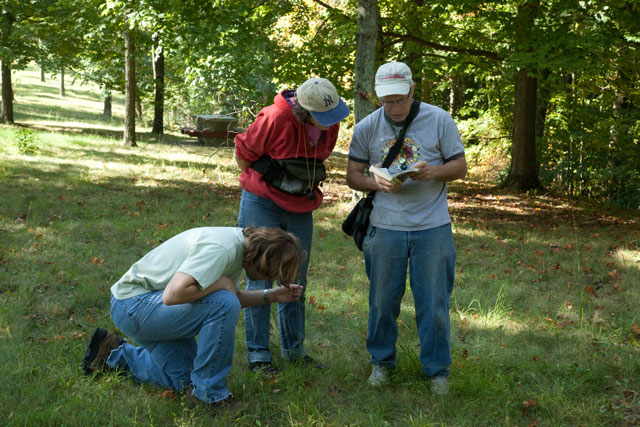
OMLA members distracted by an orchid in the grass.

Like the members of OMLA who study them, moss and lichen mix and mingle.
Even though it's just a lawn area, we managed to be some interesting vascular plants there. One of these is a fall-sporing fern, the lace-frond grape-fern, Botrychium dissectum (family Ophioglossaceae).

Lace-frond grape-fern in Meigs County rest area lawn.
This fern displays well the basis for both its genus and common name --from "the" Greek (is "the Greek" different from, say, Greek?), botrys, a bunch of grapes, alluding to the panicles of sporangia. Grape ferns have huge sporangia. Here's a closeup of the sporangia of this grape fern.

Grape fern sporangia at the Meigs County Rte 33 rest stop. Sept. 19, 2009.
Another vascular plant that caught our eye was a Spiranthes orchid, in fruit. Chances are good it's narrow-leaved ladies'-tresses, S. vernalis.

OMLA members distracted by an orchid in the grass.
A
major stop for the foray
was the Shady River State Forest. Here a rocky stream runs through the
woods.
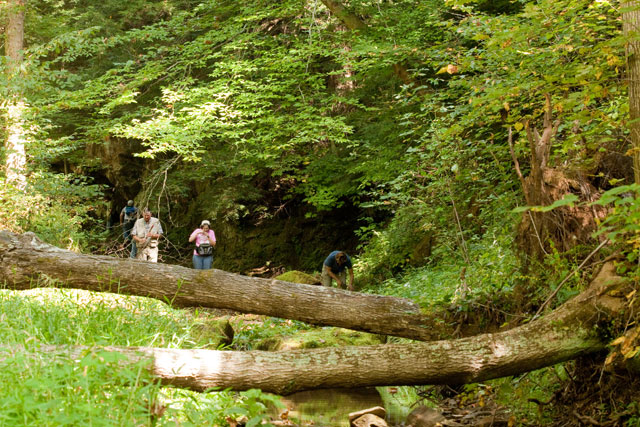
Riparian habitat at Shady River State Forest. September 19, 2009.
Consider some more lichens. Two that we encountered are somewhat unusual in that the photosynthesizing partner, the so-called "phycobiont," is not a green alga (a relatively complex "eukaryotic" organism the cells of which have membrane-bound nuclei and organelles) but instead have a prokaryotic phycobiont. It's a photosynthetic bacterium called a "cyanobacterium," or "blue-green" bacterium.
One of these lichens is a foliose, gelatinous (when wet) one lacking the layering into cortex and medulla that is present in most other lichens. Rather homogenous throughout, it is Collema subflaccidum.
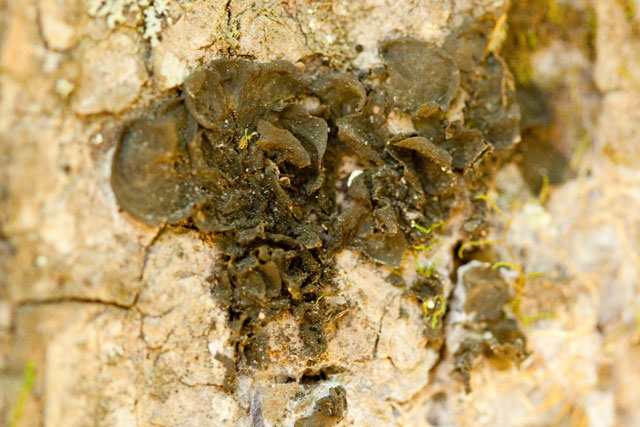
Collema subflaccidum on a tree at Shady River State Forest. Meigs County. Sept. 19, 2009.
Another lichen with a cycanobacterial phycobiont doesn't seem much different from run-of-the-mill lichens with green algal phycobionts. This is Peltigera canina, seen here on a sandstone rock on a dry wooded slope. The moss growing with it is Anomodon attenuatus (Leskeaceae).
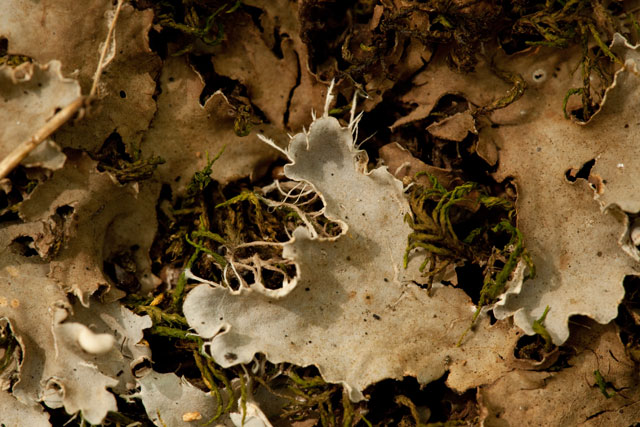
Peltigera canina lichen growing on a rock at Shade River State Forest. Meigs County, Ohio.
Lichens with an upright growth form are termed "fruticose" (shrubby) and the most well known of these are in the genus Cladonia. These lichens are characterized by having a two-fold thallus: (1) a primary thallus consisting of little flake-like "squamules," and (2) a secondary thallus consisting of "podetia," i.e., hollow, erect, potentially spore-bearing structures. Podetia are often sterile, however. The one shown below, reportedly our most common of several species having pointed and sterile podetia, is Cladonia ochrochlora.
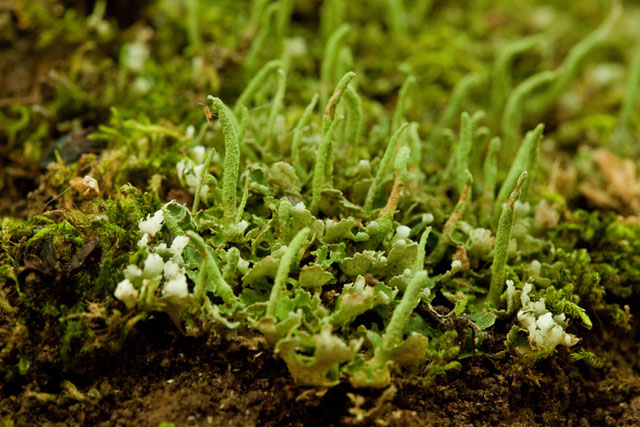
Cladonia ochrochlora at Shady River State Forest. Meigs Cty. OH Sept. 19, 2009.
Some vascular plants stand out. One of these is a pretty annual weed, common day-flower, Commelina communis (Commelinaceae). It's related to Tradescantia (spiderwort). Flowers are produced in the axils of leaflike bracts; a pair of them are shown surrounding a fruit in the picture below. The genus Commelina is distinguished by being 3-petaled, but having only two them --the upper two --showy and blue, while the lower one is pale and much smaller. The genus name, given by Linneaus, evidence of his twisted sense of humor, commemerates the brothers Commelijn. They were 17th-century Dutchmen, two of whom were prominent botanists and the third, not so much, died young.
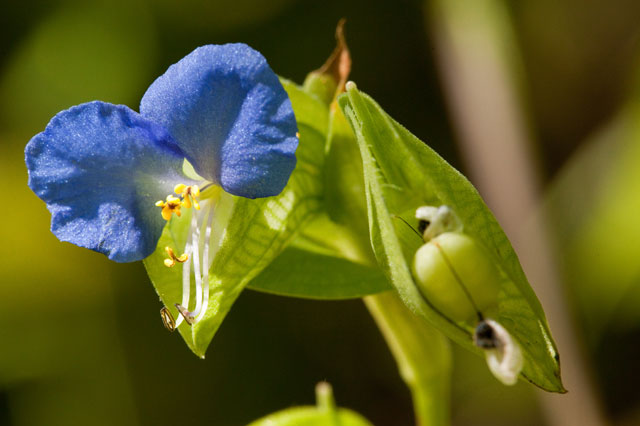
Common day-flower is a pretty annual weed at Shade River State Forest.

Riparian habitat at Shady River State Forest. September 19, 2009.
On
the rocks in the river we
saw good representatives of all three bryophyte divisions.
Mosses (Division Bryophyta) are the most abundant, speciose, and conspicuous bryophytes. Most often, their leaves are in whorls about the stem (although many are somewhat flattened). The leaves are never (in our species) lobed or divided, and the sporophytes, when present, tend to persist on the plants and are useful in identification. There are just over 400 species of mosses in Ohio.
The specimen shown below is "sterile," i.e., lacking sporophytes. While often useful for identification, sporophytes aren't always necessary to distinguish species. This moss, for example, aptly named Hyophila ("rain-loving," owing to its preference for wet habitats) involuta (because "involute" leaves have margins curled upwards) in the family Pottiaceae, has leaves that are wide-spreading when moist, but involute when dry. Even on this moist specimen though, a trace of the involuteness is apparent if you carefully scrutinize all the leaves.
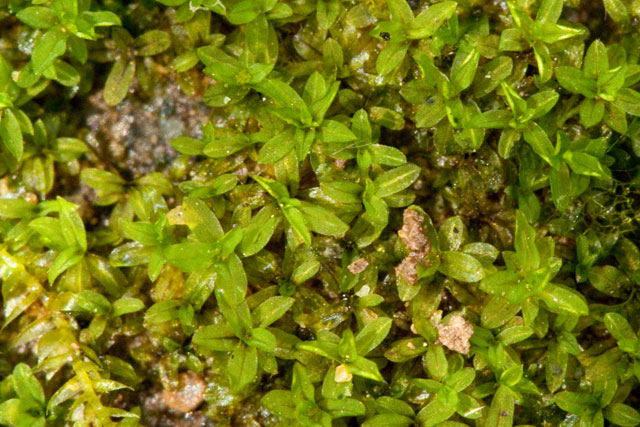
Hyophila involuta on rock in stream at Shady River State Forest. Meigs County, Ohio.
Another sterile moss
plentiful on the moist rocks was quite
a fooler. A member of a pair of closely related genera known for
having a dark, almost blackish aspect, Grimmia
and Schistidium,
this Schistidium
rivulare (Grimmiaceae),
being moist and vibrantly growing, is much greener than expected. Quite
beautiful.
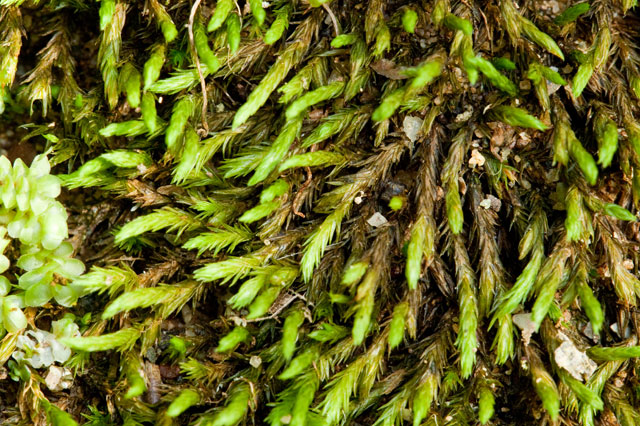
Schistidium rivulare at Shady River State Forest. September 19, 2009.
Liverworts (Division Marchantiophyta) are fairly common, but they are rarely abundant or large enough to be noticed easily. Liverworts often occur sparsely mixed in with mosses. They are quite variable. The most well known types from biology class, the tongue-shaped flattened thallose liverworts, such as Marchantia, are actually much less common than the more mossy-lookey-likey leafy liverworts. Compared to mosses, the leafy liverworts are more often flatter, with their main leaves in two ranks or rows and reduced underleaves. Also, liverwort leaves may be much more elaborate than moss leaves, being variously lobed or dissected. The leafy liverwort sporophyte is very delicate and short-lived. One-hundred twenty-two liverworts are known from Ohio.
This leafy liverwort is Scapania nemorosa (Scapaniaceae). Note that the leaves are lobed and elaborately folded (conduplicate). In this relatively easily recognized genus the upper lobe is smaller than the lower lobe.
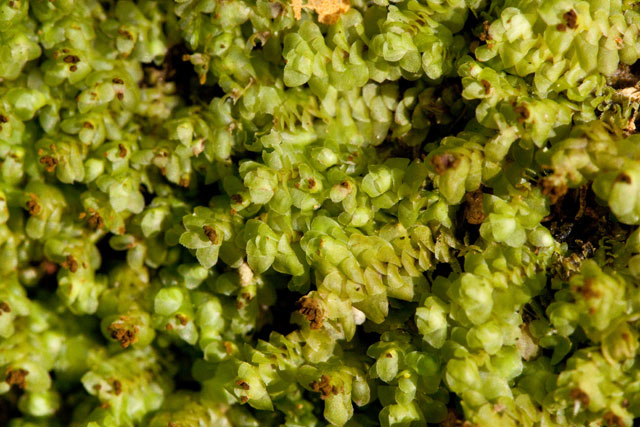
Scapania nemorosa is a leafy liverwort. Shady River State Forest. Meigs Cty OH. Sept 19, 2009
Hornworts have horn-like spore containing capsules that lengthen by means of a region of cell division --a "meristematic" region --located in an unusal place --at its base, rather than at the tip, where plant elongation usually occurs (an "apical meristem"). See below how the older portions at the sporangium split lengthwise, releasing spores.
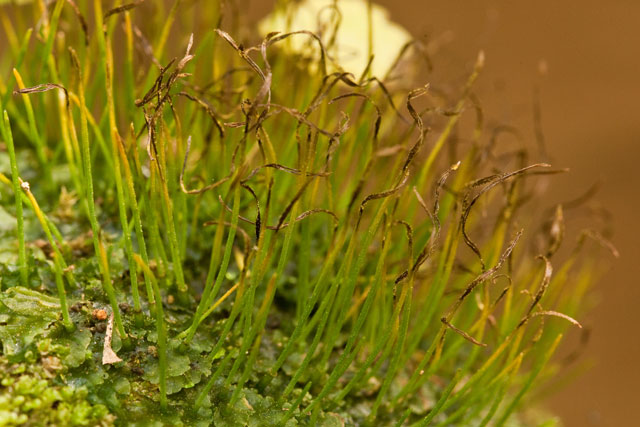
Hornwort sporophytes split lengthwise to release spores. Meigs. Sept. 19, 2009.
A log nearby is covered by several mosses having the "pleurocarp" (carpet moss) growth form. Pleurocarps lay flat, branch repeatedly, and have sporophytes issuing forth from axils of the branches. This is Callicladium haldanianum mixed with Hypnum curvifolium (the sporophytes belong to Callicladium).
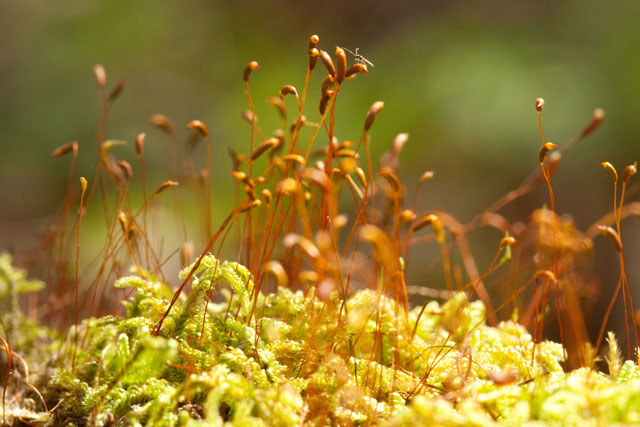
Callicladium haldanianum at Shady River State Forest. September 19, 2009.
Mosses (Division Bryophyta) are the most abundant, speciose, and conspicuous bryophytes. Most often, their leaves are in whorls about the stem (although many are somewhat flattened). The leaves are never (in our species) lobed or divided, and the sporophytes, when present, tend to persist on the plants and are useful in identification. There are just over 400 species of mosses in Ohio.
The specimen shown below is "sterile," i.e., lacking sporophytes. While often useful for identification, sporophytes aren't always necessary to distinguish species. This moss, for example, aptly named Hyophila ("rain-loving," owing to its preference for wet habitats) involuta (because "involute" leaves have margins curled upwards) in the family Pottiaceae, has leaves that are wide-spreading when moist, but involute when dry. Even on this moist specimen though, a trace of the involuteness is apparent if you carefully scrutinize all the leaves.

Hyophila involuta on rock in stream at Shady River State Forest. Meigs County, Ohio.

Schistidium rivulare at Shady River State Forest. September 19, 2009.
Liverworts (Division Marchantiophyta) are fairly common, but they are rarely abundant or large enough to be noticed easily. Liverworts often occur sparsely mixed in with mosses. They are quite variable. The most well known types from biology class, the tongue-shaped flattened thallose liverworts, such as Marchantia, are actually much less common than the more mossy-lookey-likey leafy liverworts. Compared to mosses, the leafy liverworts are more often flatter, with their main leaves in two ranks or rows and reduced underleaves. Also, liverwort leaves may be much more elaborate than moss leaves, being variously lobed or dissected. The leafy liverwort sporophyte is very delicate and short-lived. One-hundred twenty-two liverworts are known from Ohio.
This leafy liverwort is Scapania nemorosa (Scapaniaceae). Note that the leaves are lobed and elaborately folded (conduplicate). In this relatively easily recognized genus the upper lobe is smaller than the lower lobe.

Scapania nemorosa is a leafy liverwort. Shady River State Forest. Meigs Cty OH. Sept 19, 2009
Nearby,
an example of a
thallose liverwort. It's Pellia
epiphylla (family Pelliaceae)
covering
a rock, the way paper does in "rock, paper, scissors." The
game
should be changed to "rock, liverwort, pocket-knife." But that doesn't
make any sense. Yes, the
rock can break the knife, and the liverwort can
indeed cover the rock, and the pocket-knife can certainly collect the
liverwort
off of the rock. But when the knife does that that, the liverwort is
already covering the rock, and the game would be have been over over by
the time the knife arivd in the scene. Not
"paper covers rock" makes a whole lot of sense anyway!
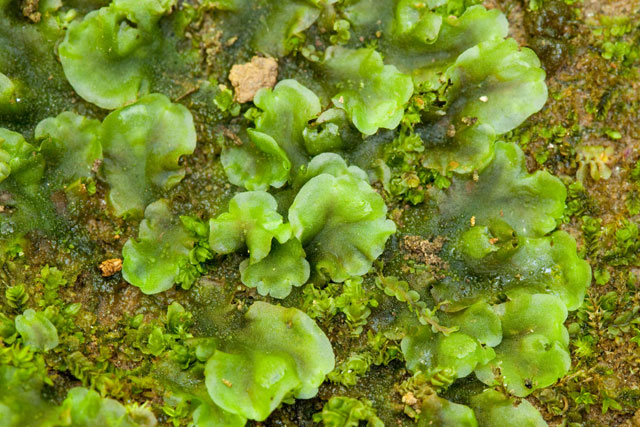
Pellia epiphylla, a thallose liverwort. Shady River State Forest. Meigs County, Ohio. Sept. 19, 1009.

Pellia epiphylla, a thallose liverwort. Shady River State Forest. Meigs County, Ohio. Sept. 19, 1009.
Hornworts
(Division
Anthoceratophyta) are uncommon and there are just a few species in OH,
but one of them grows in open disturbed places where it can be
abundant. Gametophytically, a hornwort is dorsiventrally flattened,
sprawling and irregularly shaped, suggestive of a thallose
liverwort. The sporophytes are indeed horn-like, and they split
lenthwise
starting from the top to release spores as they mature.
Although not visible in thre photo below, it is interesting to note that hornworts have small slimy clefts underneath wherein grow colonies of the nitrogen fixing cyanobacterium Nostoc, as a symbiont. This is Phaeoceros laevis.
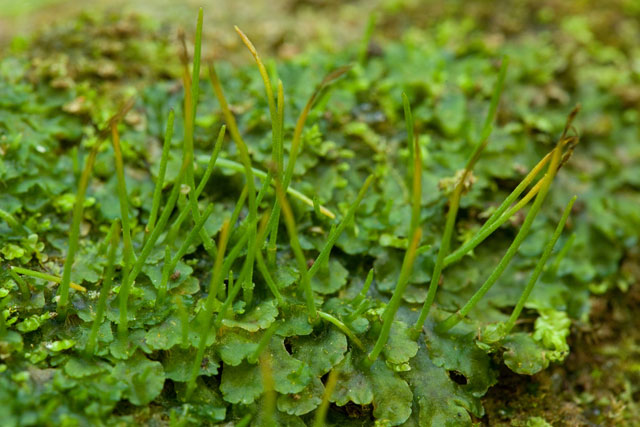
Phaeoceros laevis at Shady River State Forest. Sept. 19, 2009.
Although not visible in thre photo below, it is interesting to note that hornworts have small slimy clefts underneath wherein grow colonies of the nitrogen fixing cyanobacterium Nostoc, as a symbiont. This is Phaeoceros laevis.

Phaeoceros laevis at Shady River State Forest. Sept. 19, 2009.
Hornworts have horn-like spore containing capsules that lengthen by means of a region of cell division --a "meristematic" region --located in an unusal place --at its base, rather than at the tip, where plant elongation usually occurs (an "apical meristem"). See below how the older portions at the sporangium split lengthwise, releasing spores.

Hornwort sporophytes split lengthwise to release spores. Meigs. Sept. 19, 2009.
A log nearby is covered by several mosses having the "pleurocarp" (carpet moss) growth form. Pleurocarps lay flat, branch repeatedly, and have sporophytes issuing forth from axils of the branches. This is Callicladium haldanianum mixed with Hypnum curvifolium (the sporophytes belong to Callicladium).

Callicladium haldanianum at Shady River State Forest. September 19, 2009.
On
naturally disturbed soil
of an overturned tree along the stream, see one of the joys of autumn,
a
most distinctive moss with an unusual habit. This is Pogonatum pensylvanicum,
a member
of the Polytrichaceae. It resembles the familiar "haircap
mosses"
(Polytrichum)
by virtue of its
long-rectangular capsules atop a long seta, covered with a calyptra
composed of long silky hairs. But Pogonatum
has a much reduced (the
technical term is "itsy-bitsy") gametophyte. Much of the photosynthetic
activity of this moss is carried out by an extensive alga-like
protonema, seen as the general green cover all in the
background.
A moss protonema is normally a transitory stage that develops when a
spore germinates, and then goes away soon after gametophytes begin
developing. The persistent protonema is a special feature of Pogonatum pensylvanicum
and a just
a few other mosses. Two other examples of mosses with a persistent
protonema are various Ephemerum
species, tiny
ephemerals of open
sites, and
a most wonderful
cave-dweller, Schistostega
pennata, called
"goblin's gold" or the "luminous moss"
because of refelective properties of special protonemal cells that
capture light.
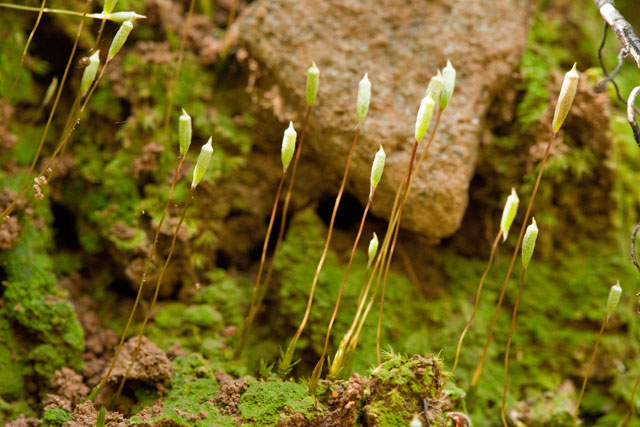
Pogonatum pensylvanicum at Shady River State Forest. Sept. 19, 2009.

Pogonatum pensylvanicum at Shady River State Forest. Sept. 19, 2009.
Consider some more lichens. Two that we encountered are somewhat unusual in that the photosynthesizing partner, the so-called "phycobiont," is not a green alga (a relatively complex "eukaryotic" organism the cells of which have membrane-bound nuclei and organelles) but instead have a prokaryotic phycobiont. It's a photosynthetic bacterium called a "cyanobacterium," or "blue-green" bacterium.
One of these lichens is a foliose, gelatinous (when wet) one lacking the layering into cortex and medulla that is present in most other lichens. Rather homogenous throughout, it is Collema subflaccidum.

Collema subflaccidum on a tree at Shady River State Forest. Meigs County. Sept. 19, 2009.
Another lichen with a cycanobacterial phycobiont doesn't seem much different from run-of-the-mill lichens with green algal phycobionts. This is Peltigera canina, seen here on a sandstone rock on a dry wooded slope. The moss growing with it is Anomodon attenuatus (Leskeaceae).

Peltigera canina lichen growing on a rock at Shade River State Forest. Meigs County, Ohio.
Lichens with an upright growth form are termed "fruticose" (shrubby) and the most well known of these are in the genus Cladonia. These lichens are characterized by having a two-fold thallus: (1) a primary thallus consisting of little flake-like "squamules," and (2) a secondary thallus consisting of "podetia," i.e., hollow, erect, potentially spore-bearing structures. Podetia are often sterile, however. The one shown below, reportedly our most common of several species having pointed and sterile podetia, is Cladonia ochrochlora.

Cladonia ochrochlora at Shady River State Forest. Meigs Cty. OH Sept. 19, 2009.
Some vascular plants stand out. One of these is a pretty annual weed, common day-flower, Commelina communis (Commelinaceae). It's related to Tradescantia (spiderwort). Flowers are produced in the axils of leaflike bracts; a pair of them are shown surrounding a fruit in the picture below. The genus Commelina is distinguished by being 3-petaled, but having only two them --the upper two --showy and blue, while the lower one is pale and much smaller. The genus name, given by Linneaus, evidence of his twisted sense of humor, commemerates the brothers Commelijn. They were 17th-century Dutchmen, two of whom were prominent botanists and the third, not so much, died young.

Common day-flower is a pretty annual weed at Shade River State Forest.
A
goldenrod that isn't
golden! This is withe-rod ("white" rod), Solidago bicolor
(Asteraceae), a
wand-like woodland perennial with creamy white flower heads.
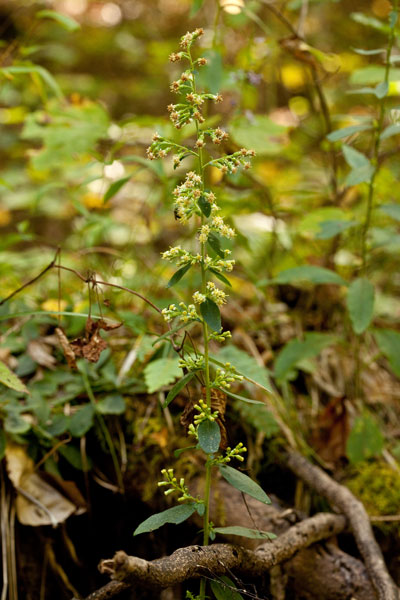
Solidago bicolor at Shady River.

Solidago bicolor at Shady River.


